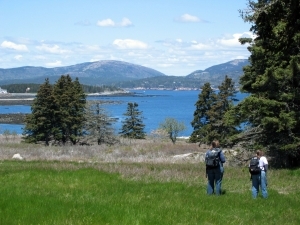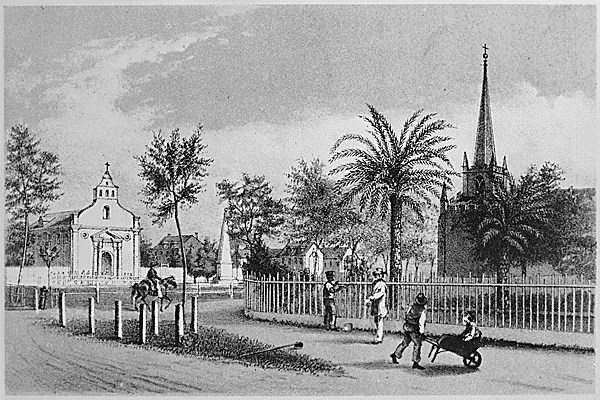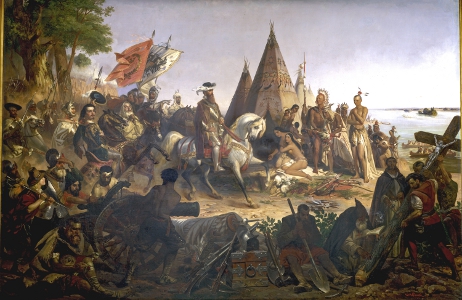
Above: Painting, entitled Discovery of the Mississippi, by William H. Powell, 1847, is located in the Rotunda of the Capitol in Washington, D.C. Right: Giovanni de Verrazzano, 1889, engraving by F. Allcarini, Tocchi, courtesy Wikipedia Commons.
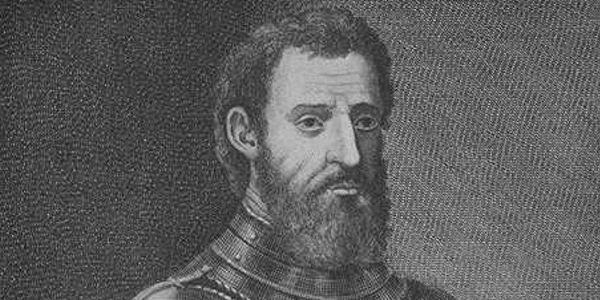
Click here to Sponsor the page and how to reserve your ad.
-
Timeline
Detail - 1527
June 17, 1527 - The Narváez expedition leaves Spain to explore and colonize Spanish Florida under the command of Pánfilo de Narváez. There were 600 members of the expedition.
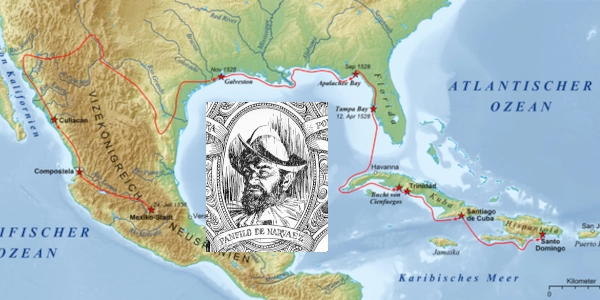
Pánfilo de Narváez was another in the line of Spanish explorers sent by the King to colonize the New World, and for some reason, he's not as famous as the others we know well; i.e. Columbus, de Soto, Coronado. Maybe that's because, in the end, it didn't turn out well, although that could be said about the others, too. But it was ambitious, and it was broad, eventually covering not only Florida, but the southeast and southwest of an eventual United States.
Narváez had been to the Americas before, arriving, as a soldier, in Jamaica in 1510. He had been an escort to Bartolome de las Casas, the eventual Bishop of Chiapas; he had attempted to stop an unauthorized invasion of Hernán Cortés into Mexico in 1520. Narváez had failed in that attempt, despite a nine hundred to one hundred advantage in men, taken prisoner for three years, then returned to Spain.
The King did not hold that failure against him. On December 25, 1526, Pánfilo de Narváez was given an even more ambitious and important task by King Carlos V, Holy Roman Emporer, also known as King Carlos I of Spain, he was to sail to Florida, explore the peninsula, and colonize it. The mission was to be completed in one year. It had several specific goals. The expedition was tasked with founding two towns of one hundred persons each. It was also to build two forts along the coast. Pánfilo de Narváez was to privately fund the excursion, but give twenty percent of the profits to the crown.

The Voyage
On June 17, 1527, Narváez left Sanlúcar de Barrameda, Spain with five ships and six hundred men composed of four hundred and fifty soldiers plus one hundred and fifty sailors, slaves, wives, and Franciscan priests from Spain, Portugal, Greece, and Italy. It included Álvar Núñez Cabeza de Vaca serving as second commander, treasurer, and sheriff, who would later write extensively about the voyage and exploration. He was one of the few survivors who could.
The excursion to Florida did not go well. At the Canary Islands, eight hundred miles into the journey, they resupplied with food and water. By August, they had reached Santo Domingo in Hispaniola, today's Haiti and Dominican Republic. Once in Hispaniola, news of a former expedition by Lucas Vázquez de Ayllón to found the colony of San Miguel de Gualdape in Georgia, reached the men. It had not gone well either, lasting only three months in 1526 and costing the lives of more than three quarters of its six hundred men. Within one month, Narváez had lost one hundred and forty men to desertion.
The expedition continued toward Cuba in September, now gaining horses and one small ship in which to explore the coast of Florida upon arrival. Once in Cuba, Narváez split his forces to gather more supplies. Cabeza de Vaca captained two ships to Trinidad; Narváez captained four ships to the southern coast of Cuba. The de Vaca ships arrived in Trinidad circa October 30, a few days later a hurricane sank them both, killing sixty and destroying all of the new supplies.
Over the next four months of winter, Pánfilo de Narváez attempted to regroup, restock his supplies, and recruit more men. He purchased two new ships. By February of 1528, the expedition had four hundred men, six ships, and eighty horses. They left for Havana from Cienfuegos on the southern coast. Two days later, all ships had run aground on the Canarreos shoals, stuck for three weeks. After a March storm floated the ships, they headed again for Havana, but the winds were too strong to make landfall there, pushing the expedition ships into the Gulf of Mexico. For another month, they battled the currents of the Gulf Stream.
Pánfilo de Narváez was determined to meet the colonization goals, however, finally pushing north toward the west coast of Florida. The expedition arrived there, sighting land near Tampa, on April 12, 1528. Three days later, after searching for a suitable harbor and losing another ship, they would debark.

Excerpts from "The Journey of Alvar Núñez Cabeza De Vaca," 1542
Expedition Departs from Spain
"On the 27th day of the month of June, 1527, the Governor Panfilo de Narvaez departed from the port of San Lucar de Barrameda, with authority and orders from Your Majesty to conquer and govern the provinces that extend from the river of the Palms to the Cape of the Florida, these provinces being on the main land. The fleet he took along consisted of five vessels, in which went about 600 men. The officials he had with him (since they must be mentioned) were those here named: Cabeza de Vaca, treasurer and alguacil mayor; Alonso Enriquez, purser; Alonso de Solis, factor of Your Majesty and inspector. A friar of the order of Saint Francis, called Fray Juan [Suarez], went as commissary, with four other monks of the order. We arrived at the island of Santo Domingo, where we remained nearly forty-five days, supplying ourselves with necessary things, especially horses. Here more than 140 men of our army forsook us, who wished to remain, on account of the proposals and promises made them by the people of the country. From there we started and arrived at Santiago (a port on the Island of Cuba) where, in the few days that we remained the Governor supplied himself again with people, arms and horses. It happened there that a gentleman called Vasco Porcallo, a resident of la Trinidad (which is on the same island), offered to give the Governor certain stores he had at a distance of 100 leagues from the said harbor of Santiago." Cabeza de Vaca 1542.
Image above: Montage of the Map of the Narváez and de Vaca Expedition (background), 2008, Lancer and (inset) engraving of Pánfilo de Narváez, date unknown. Both images courtesy Wikipedia Commons. Photo below: Sign at the site of the expedition landing at Jungle Prada outside St. Petersburg, 2011, Ebyabe. Courtesy Wikipedia Commons, CC 3.0. Source info: "The Journey of Alvar Núñez Cabeza De Vaca," 1542; "The Narváez Expedition," historians.org; floridahistory.com; Wikipedia.




